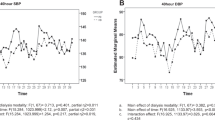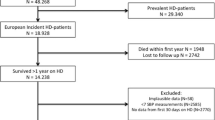Abstract
The aim of this study was to compare the results of the 44-h ambulatory blood pressure monitoring (ABPM) data between haemodialysis (HDp) and CAPD patients and to investigate the relation of circadian rhythm in blood pressure (BP) with development of left ventricular hypertrophy. Twenty-two HDp (11 male, 11 female, mean age: 50 ± 17 years) and 24 CAPDp (11 male, 13 female, mean age: 47 ± 15 years) were included. Echocardiographic measurements and ABPM were performed in all study groups. ABPM of the first and second days were analysed separately and compared with CAPDp. Left ventricular hypertrophy was detected in 17 of the 22 HDp (77%) and 17 of the 24 CAPDp (71%). There was no significant differences between HD and CAPDp in respect to 44-h, daytime and night-time systolic and diastolic BP values. Although the course of BP in CAPDp was stable during the 44-h period, systolic and diastolic BP levels on the second day were significantly higher than those of on the first day in HDp (P < 0.001 for both). Daytime systolic and diastolic BP levels on the first day in HD group were recorded lower than those of theCAPD group. On the second day, night-time BP readings (both systolic and diastolic BP) were measured significantly higher in the HD group compared with the CAPD group. Twenty-one of the 24 (88%) CAPD patients were dippers, whereas only four of the 22 (18%) HDp were dippers (P < 0.001). Dipper patients had significantly lower left ventricular mass index (LVMI) than non-dipper patients (131 ± 29 g/m2 vs 153 ± 40 g/m2, P = 0.03). In 44-h ABPM, there were no differences in daytime and night-time systolic and diastolic blood pressures between HD and CAPD patients. Non-dipper patients had increased LVMI as compared with dipper patients. Abnormalities in circadian rhythm of the blood pressure might be one of the implicated factors for development of left ventricular hypertrophy.
This is a preview of subscription content, access via your institution
Access options
Subscribe to this journal
Receive 12 digital issues and online access to articles
$119.00 per year
only $9.92 per issue
Buy this article
- Purchase on Springer Link
- Instant access to full article PDF
Prices may be subject to local taxes which are calculated during checkout

Similar content being viewed by others
References
Katzarski KS et al. Fluid state and blood pressure control inpatients treated with long and short haemodialysis Nephrol Dial Transplant 1999; 14: 369–375
Alvarez-Lara MA et al. Blood pressure and body water distribution in chronic renal failurepatients Nephrol Dial Transplant 2001; 16 (Suppl 1): 94–97
Gunal AI et al. Strict volume control normalizes hypertension in peritoneal dialysispatients Am J Kidney Dis 2001; 37: 588–593
Amar J et al. Nocturnal blood pressure and 24-hour pulse pressure are potent indicators of mortality in hemodialysispatients Kidney Int 2000; 57: 2485–2491
Erturk S et al. Relationship of ambulatory blood pressure monitoring data to echocardiographic findings in hemodialysispatients Nephrol Dial Transplant 1996; 11: 2050–2054
Lingens N et al. Ambulatory blood pressure monitoring in paediatricpatients treated by regular haemodialysis and peritoneal dialysis Pediatr Nephrol 1995; 9: 167–172
Verdecchia P et al. Blunted nocturnal fall in blood pressure in hypertensive women with future cardiovascular morbid events Circulation 1993; 88: 986–992
Coomer RW, Schulman G, Breyer JA, Shyr Y . Ambulatory blood pressure monitoring in dialysispatients and estimation of mean interdialytic blood pressure Am J Kidney Dis 1997; 29: 678–684
Rodby RA, Vonesh EF, Korbet SM . Blood pressures in hemodialysis and peritoneal dialysis using ambulatory blood pressure monitoring Am J Kidney Dis 1994; 23: 401–411
Declaration of Helsinki. Recommendations Guiding Physicians in Biomedical Research Involving Human Subjects 41st World Medical Assembly, Hong Kong September 1989
Henry WL et al. Report of the American Society of Echocardiography Committe on nomenculature and standarts in two dimensional echocardiography Circulation 1980; 62: 212–217
Sahn DJ, DeMaria A, Kisslo J, Weyman A . Recommendations regarding quantitation in M Mode echocardiographic measurements Circulation 1978; 58: 1072–1083
Devereux RB et al. Methods for detection of left ventricular hypertrophy: application to hypertensive heart disease Eur Heart J 1993; 14 (Suppl D): 8–15
Devereux RB, Reichek N . Echocardiographic determination of left ventricular mass in men. Anatomic validation of the method Circulation 1977; 55: 613–618
Staessen JA, Bieniaszewski L, O Brien ET, Fagard R . What is normal blood pressure on ambulatory monitoring? Nephrol Dial Transplant 1996; 11: 241–245
Velasquez MT et al. Control of hypertension is better during hemodialysis than during continuous ambulatory peritoneal dialysis in ESRDpatients Clin Nephrol 1997; 48: 341–345
Sturrock ND et al. 4 Non-dipping circadian blood pressure and renal impairment are associated with increased mortality in diabetes mellitus Diabet Med 2000; 17: 360–364
White WB . How well does ambulatory blood pressure predict target-organ disease and clinical outcome inpatients with hypertension? Blood Press Monit 1999; 4 (Suppl 2): S17–S21
Korzets Z, Erdberg A, Galan E, Bernheim J . Does diurnal variation in blood pressure exist in CAPD patients? Nephrol Dial Transplant 1994; 9: 274–276
Farmer CK et al. An investigation of the effect of advancing uraemia, renal replacement therapy and renal transplantation on blood pressure variability Nephrol Dial Transplant 1997; 12: 2301–2307
Cocchi R et al. Prevalence of hypertension inpatients on peritoneal dialysis: results of an Italian multicentre study Nephrol Dial Transplant 1999; 14: 1536–1540
Chazot C et al. Interdialysis blood pressure control by long haemodialysis sessions Nephrol Dial Transplant 1995; 10: 831–837
Covic A, Goldsmith DJ, Covic M . Reduced blood pressure diurnal variability as a risk factor for progressive left ventricular dilatation in hemodialysispatients Am J Kidney Dis 2000; 35: 617–623
London GM, Drüeke TB . Atherosclerosis and arteriosclerosis in chronic renal failure Kidney Int 1997; 51: 1678–1695
London GM et al. Cardiac and arterial interactions in end-stage renal disease Kidney Int 1996; 50: 600–608
Author information
Authors and Affiliations
Corresponding author
Rights and permissions
About this article
Cite this article
Tonbul, Z., Altintepe, L., Sözlü, Ç. et al. Ambulatory blood pressure monitoring in haemodialysis and continuous ambulatory peritoneal dialysis (CAPD) patients. J Hum Hypertens 16, 585–589 (2002). https://doi.org/10.1038/sj.jhh.1001449
Received:
Revised:
Accepted:
Published:
Issue Date:
DOI: https://doi.org/10.1038/sj.jhh.1001449
Keywords
This article is cited by
-
Prognostic values of left ventricular mass index progression in incident peritoneal dialysis patients : a prospective cohort study
BMC Nephrology (2022)
-
Peritoneal Dialysis Guidelines 2019 Part 1 (Position paper of the Japanese Society for Dialysis Therapy)
Renal Replacement Therapy (2021)
-
Ambulatory blood pressure profile and blood pressure variability in peritoneal dialysis compared with hemodialysis and chronic kidney disease patients
Hypertension Research (2020)
-
Factors associated with systolic hypertension in peritoneal dialysis patients
Journal of Nephrology (2020)
-
Night-time blood pressure and pulse wave velocity in dialysis patients
Clinical and Experimental Nephrology (2018)



